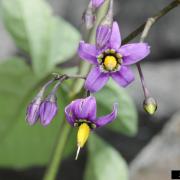Invasive Species: Solanum dulcamara, Bittersweet Nightshade
Bittersweet nightshade is an invasive perennial plant native to Eurasia. Plants can reach up to 6.6 ft. (2 m) tall, either erect or clambering. Leaves are petiolate, alternate, three-lobed (upper part of the stem), acuminate, and up to 3.1 in. (8 cm) long. Flowering occurs in May to November when purple flowers develop. Petals are recurved and up to 0.4 in. (9 mm) long. Stamens (5) are bright yellow and fused together around the stigma. Mature fruits are berries that are red, shiny, and 0.4 in. (1 cm) long. Plants invade thickets, fence rows, pond margins, low woods, and roadsides. All parts of the plants are toxic.
What are invasive species and why should we be concerned about them?
Taxonomy: Scientific and Common Names for This Species
Solanales > Solanaceae > Solanum dulcamara L.
Synonym(s): climbing nightshade, blue nightshade, European bittersweet, fellenwort, woody nightshade
Solanum dulcamara – USDA PLANTS Profile
Distribution Maps
Bittersweet nightshade – The reported distribution of this invasive species across the United States. (Source: Invasive Plant Atlas of the United States)
Up-to-the-minute distribution maps and why they are important
Reporting This Invasive Species
What is the best way and place to report the occurrence of an invasive species?
How to report an invasive species sighting to EDDMapS – Early Detection & Distribution Mapping System
EDDMapS – Report an invasive species to EDDMapS
Cooperative Extension Offices – Find your local Cooperative Extension office on this map provided by USDA
How to Identify
This invasive species can be identified by looking for the characteristics described in the paragraphs that follow.
Plant
An invasive perennial plant native to Eurasia. Plants can reach up to 6.6 ft. (2 m) tall, either erect or clambering.
 |
 |
| Leslie J. Mehrhoff, University of Connecticut, bugwood.org | Leslie J. Mehrhoff, University of Connecticut, bugwood.org |
Foliage
Leaves are petiolate, alternate, three-lobed (upper part of the stem), acuminate, and up to 3.1 in. (8 cm) long.
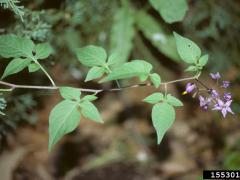 |
 |
| Theodore Webster, USDA Agricultural Research Service, bugwood.org | John Cardina, The Ohio State University, bugwood.org |
Flower
Flowering occurs in May to November when purple flowers develop. Petals are recurved and up to 0.4 in. (9 mm) long. Stamens (5) are bright yellow and fused together around the stigma.
|
|
 |
|
Rob Routledge, Sault College,bugwood.org |
David Cappaert, Michigan State University, bugwood.org |
Fruit
Mature fruits are berries that are red, shiny, and 0.4 in. (1 cm) long.
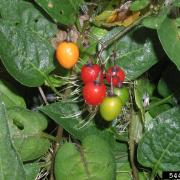 |
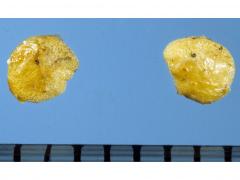 |
|
Leslie J. Mehrhoff, University of Connecticut, |
John Cardina, The Ohio State University, bugwood.org |
Native Species That Resemble Bittersweet Nightshade
Solanum triflorum, cutleaf nightshade – Images at invasive.org
This species is native to the United States but can be considered nonnative to areas of Canada.
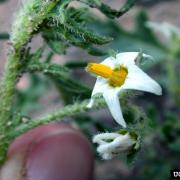 |
 |
| Mary Ellen (Mel) Harte, bugwood.org | Mary Ellen (Mel) Harte, bugwood.org |
– Images at invasive.org
| bugwood.org | bugwood.org |
Additional Images for Bittersweet Nightshade
Bittersweet nightshade – Images at Invasive.org
Learning Resources for Bittersweet Nightshade
Additional Information, Biology, Control and Management Resources
Control and management recommendations vary according to individual circumstances. Location, habitat, weather, and a variety of other conditions are factors that help determine the best treatment choice. To find the safest and most effective treatment for your situation, consult your state’s land-grant institution. If you will use chemicals as part of the control process, always refer to the product label.
United States Land-Grant University System – Find your land-grant university’s College of Agriculture, Cooperative Extension Service, or other related partner on this map provided by USDA.
Invasive Plant Atlas of New England – EDDMapS
Weed of the Week – USDA Forest Service
Noxious Weeds – King County
Fire Effects Information System – USDA Forest Service
Species Details – The Natural History Museum
Ohio Perennial & Biennial Weed Guide – Ohio State University
Jepson Herbarium – University of California

